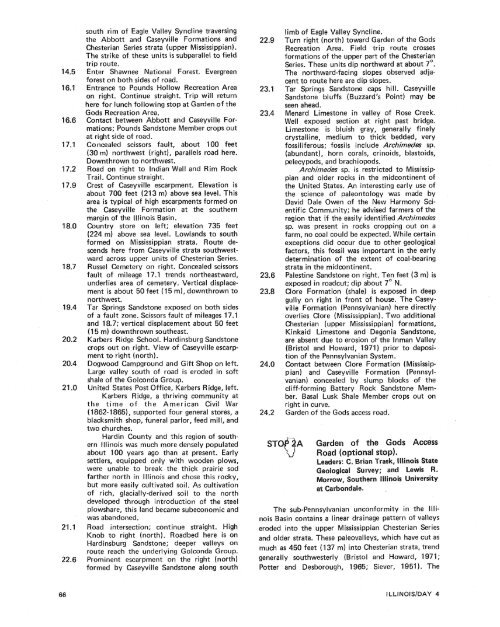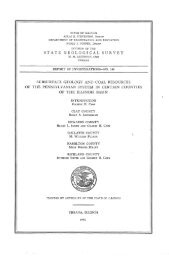Edited by James E. Palmer and Russell R. Dutcher - University of ...
Edited by James E. Palmer and Russell R. Dutcher - University of ...
Edited by James E. Palmer and Russell R. Dutcher - University of ...
You also want an ePaper? Increase the reach of your titles
YUMPU automatically turns print PDFs into web optimized ePapers that Google loves.
south rim <strong>of</strong> Eagle Valley Syncline traversingthe Abbott <strong>and</strong> Caseyville Formations <strong>and</strong>Chesterian Series strata (upper Mississippian).The strike <strong>of</strong> these units is subparallel to fieldtrip route.Enter Shawnee National Forest. Evergreenforest on both sides <strong>of</strong> road.Entrance to Pounds Hollow Recreation Areaon right. Continue straight. Trip will returnhere for lunch following stop at Garden <strong>of</strong> theGods Recreation Area.Contact between Abbott <strong>and</strong> Caseyville Formations;Pounds S<strong>and</strong>stone Member crops outat right side <strong>of</strong> road.Concealed scissors fault, about 100 feet(30 m) northwest (right), parallels road here.Downthrown to northwest.Road on right to Indian Wall <strong>and</strong> RimTrail. Continue straight.Crest <strong>of</strong> Caseyville escarpment. Elevation isabout 700 feet (213 m) above sea level. Thisarea is typical <strong>of</strong> high escarpments formed onthe Caseyville Formation at the southernmargin <strong>of</strong> the Illinois Basin.Country store on left; elevation 735 feet(224 m) above sea level. Lowl<strong>and</strong>s to southformed on Mississippian strata. Route descendshere from Caseyville strata southwestwardacross upper units <strong>of</strong> Chesterian Series.Russel Cemetery on right. Concealed scissorsfault <strong>of</strong> mileage '17.1 trends northeastward,underlies area <strong>of</strong> cemetery. Vertical displacementis about 50 feet (1 5 m), downthrown tonorthwest.Tar Springs S<strong>and</strong>stone exposed on both sides<strong>of</strong> a fault zone. Scissors fault <strong>of</strong> mileages 17.1<strong>and</strong> 18.7; vertical displacement about 50 feet(1 5 m) downthrown southeast.Karbers Ridge School. Hardinsburg S<strong>and</strong>stonecrops out on right. View <strong>of</strong> Caseyville escarpmentto right (north).Dogwood Campground <strong>and</strong> Gift Shop on left.Large valley south <strong>of</strong> road is eroded in s<strong>of</strong>tshale <strong>of</strong> the Golconda Group.United States Post Office, Karbers Ridge, left.Karbers Ridge, a thriving community atthe time <strong>of</strong> the American Civil War(1862-1 865), supported four general stores, ablacksmith shop, funeral parlor, feed mill, <strong>and</strong>two churches.Hardin County <strong>and</strong> this region <strong>of</strong> southernIllinois was much more densely populatedabout 100 years ago than at present. Earlysettlers, equipped only with wooden plows,were unable to break the thick prairie sodfarther north in lllinois <strong>and</strong> chose this rocky,but more easily cultivated soil. As cultivation<strong>of</strong> rich, glacially-derived soil to the northdeveloped through introduction <strong>of</strong> the steelplowshare, this l<strong>and</strong> became subeconomic <strong>and</strong>was ab<strong>and</strong>oned.Road intersection; continue straight. HighKnob to right (north). Roadbed here is onHardinsburg S<strong>and</strong>stone; deeper valleys onroute reach the underlying Golconda Group.Prominent escarpment on the right (north)formed <strong>by</strong> Caseyville S<strong>and</strong>stone along southlimb <strong>of</strong> Eagle Valley Syncline.Turn right (north) toward Garden <strong>of</strong> the GodsRecreation Area. Field trip route crossesformations <strong>of</strong> the upper part <strong>of</strong> the ChesterianSeries. These units dip northward at about 7".The northward-facing slopes observed adjacentto route here are dip slopes.Bar Springs S<strong>and</strong>stone caps hill. CaseyvilleS<strong>and</strong>stone bluffs (Buzzard's Point) may beseen ahead.Menard Limestone in valley <strong>of</strong> Rose Creek.Well exposed section at right past bridge.Limestone is bluish gray, general1 y finelycrystalline, medium to thick bedded, veryfossiliferous; fossils include Archimedes sp.(abundant), horn corals, crinoids, blastoids,pelecypods, <strong>and</strong> brachiopods.Archimedes sp. is restricted to Mississippian<strong>and</strong> older rocks in the midcontinent <strong>of</strong>the United States. An interesting early use <strong>of</strong>the science <strong>of</strong> paleontology was made <strong>by</strong>David Dale Owen <strong>of</strong> the New Harmony ScientificCommunity; he advised farmers <strong>of</strong> theregion that if the easily identified Archimedessp. was present in rocks cropping out on afarm, no coal could be expected. While certainexceptions did occur due to other geologicalfactors, this fossil was important in the earlydetermination <strong>of</strong> the extent <strong>of</strong> coal-bearingstrata in the midcontinent.Palestine S<strong>and</strong>stone on right. Ten feet (3 m) isexposed in roadcut; dip about 7" N.Clore Formation (shale) is exposed in deepgully on right in front <strong>of</strong> house. The CaseyvilleFormation (Pennsylvanian) here directlyoverlies Clore (Mississippian). Two additionalChesterian (upper Mississippian) formations,Kinkaid Limestone <strong>and</strong> Degonia S<strong>and</strong>stone,are absent due to erosion <strong>of</strong> the lnman Valley(Bristol <strong>and</strong> Howard, 1971) prior to deposition<strong>of</strong> the Pennsylvanian System.Contact between Clore Formation (Mississippian)<strong>and</strong> Caseyville Formation (Pennsylvanian)concealed <strong>by</strong> slump blocks <strong>of</strong> thecliff-forming Battery Rock S<strong>and</strong>stone Member.Basal tusk Shale Member crops out onright in curve.Garden <strong>of</strong> the Gods access road.The sub-Pennsylvanian unconformity in the IllinoisBasin contains a linear drainage pattern <strong>of</strong> valleyseroded into the upper Mississippian Chesterian Series<strong>and</strong> older strata. These paleovalleys, which have cut asmuch as 450 feet (1 37 m) into Chesterian strata, trendgenerally southwesterly (Bristol <strong>and</strong> Howard, 1971 ;Potter <strong>and</strong> Desborough, 1965; Siever, 1951). The
















